
Prelude
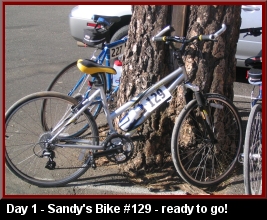 It started so innocently: Sandy (my wife) sent me a rather innocuous e-mail one day at work in the early
spring of 2004: "Would you be interested in doing a
3 day bike trek
in September to benefit the Sacramento Lung Association?" My idea of exercise
at the time was limited to heavy "channel surfing" on Dish Network in the
evenings after work, coupled with the occasional trip to the refrigerator for a soothing beverage and maybe
some popcorn. The ski season was winding down and Sandy was gently
and patiently doing her best to get me off the couch and out into nature. So partly due to couch-potato
induced guilt and partly at the suggestion of my wife, I said, "Sure. Why not?" I mean, really...how hard
could it be?
It started so innocently: Sandy (my wife) sent me a rather innocuous e-mail one day at work in the early
spring of 2004: "Would you be interested in doing a
3 day bike trek
in September to benefit the Sacramento Lung Association?" My idea of exercise
at the time was limited to heavy "channel surfing" on Dish Network in the
evenings after work, coupled with the occasional trip to the refrigerator for a soothing beverage and maybe
some popcorn. The ski season was winding down and Sandy was gently
and patiently doing her best to get me off the couch and out into nature. So partly due to couch-potato
induced guilt and partly at the suggestion of my wife, I said, "Sure. Why not?" I mean, really...how hard
could it be?
The Training
Soon thereafter, the details started to emerge: 3 days on a bike. Camping overnight. Elevations between 800
and 2,700 feet (huh?) 25 to 40 miles a day (did I really say I would do this?). This was beginning to get
serious. I dutifully tucked these concerns in the back of my mind. I mean really...September was months
away. There would be plenty of time later to get in shape for this thing.
Spring was melting away and summer was beginning. There was just so much to do besides bike riding.
There was the backyard to finish
, the Family Reunion over July 4th weekend in Tennessee, and the ever-present business trips for work.
It was long about the end of July before we ever got down to starting to train.
The Sacramento area is blessed with a wonderful
multi-purpose trail (cycling, jogging, horseback riding, etc.)
trail that winds 32 miles from Discovery Park in Downtown Sacramento up to Folsom Lake in the Sierra Nevada
foothills.
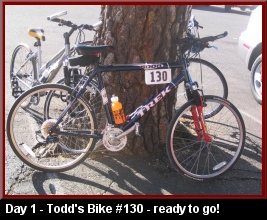 Training central for Todd and Sandy. Our weapons for this mission were a Trek 6000
Mountain Bike (Todd) and a Trek 820 mountain Bike (Sandy). Despite the fact
that this was a road tour, we didn't feel that we needed to sink another $600 to $800 each for entry-level to
intermediate level road bikes: We would make do with what we had.
Training central for Todd and Sandy. Our weapons for this mission were a Trek 6000
Mountain Bike (Todd) and a Trek 820 mountain Bike (Sandy). Despite the fact
that this was a road tour, we didn't feel that we needed to sink another $600 to $800 each for entry-level to
intermediate level road bikes: We would make do with what we had.
Our first excursions were small: 6 to 10 miles on the trail. Even these short distances proved to be a wake-up
call. Saddle soreness from 10 miles? Stiff legs? OK...this just got serious. We started doing 20-30 miles each day
on the weekends, supplemented by 12 to 18 mile rides after work about 3 times during the work week. We
definitely made progress: The saddle soreness disappeared, the legs seemed to have just a little bit more
strength after each successive ride, but we were still nowhere close to the 30 to 40 mile per day endurance that
we would need for this trek, so we decided to supplement our physical training with upgrading our equipment.
Crossbar extensions appeared, then biking gloves, followed by biking shorts, jerseys, helmets, bike computers,
shoes...anything that could give us the elusive "edge" during the trek.
My training schedule hit a snag with the inclusion of a last-minute business trip to Vancouver, BC
for two days right before the trek. This meant that I had to start the
Trek without having ridden at all for the previous 5 days! Oh well....I figured that it was probably a good idea to "save
my legs" for the Trek.
Day 1: Apple Hill to Plymouth (35.6 miles)
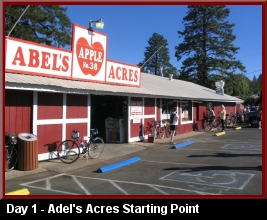 The day arrived crisp and clear - no, wait a minute, thatís not right. The day arrived HOT! The middle of September is
usually an interesting time of year in Northern California. It usually signals the start of fall, with temperatures in the upper
80s and lower 90s - a great time of year: The mornings are pleasantly cool, and the evenings after about 4:00 are
delightfully comfortable. Of course, this is not always true. Case in point? Our wedding on September 30, 2001.
The weather had been fantastic up until the day of our wedding when the mercury decided to push 100+ degrees. Well,
it seems that mother nature has a bit of a grudge against us in September: Day 1 of the bike trek was to top out at
about 102 degrees!
The day arrived crisp and clear - no, wait a minute, thatís not right. The day arrived HOT! The middle of September is
usually an interesting time of year in Northern California. It usually signals the start of fall, with temperatures in the upper
80s and lower 90s - a great time of year: The mornings are pleasantly cool, and the evenings after about 4:00 are
delightfully comfortable. Of course, this is not always true. Case in point? Our wedding on September 30, 2001.
The weather had been fantastic up until the day of our wedding when the mercury decided to push 100+ degrees. Well,
it seems that mother nature has a bit of a grudge against us in September: Day 1 of the bike trek was to top out at
about 102 degrees!
Despite our concerns about the weather, Day 1
didn't look too bad on paper: Start at Able Acres in
Apple Hill near Placerville, CA
at an elevation of 2,638 feet, and head roughly south for approximately 35 miles to the
Placer County fairgrounds in Plymouth, CA
at an elevation of about 1,000 feet. I mean how hard could it really be? We were fresh (had not ridden in 5 days) and it was mostly
downhill!
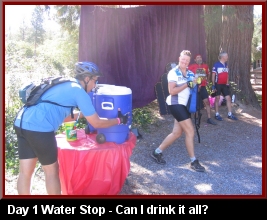 After our "team photos", we started out at about 9:30 am. To build rider confidence, the first couple of miles was straight downhill.
Piece of cake. As the name of the start implies, we made our way past apple orchards, through a small 1800 era town and south
across US Highway 50 onto our first uphill (of many) of the day on Newton Rd. After a small climb, we enjoyed another nice downhill
run to Fort Jim Rd. Sandy and I were very acquainted with Fort Jim Rd - there is a small bed-n-breakfast/ranch called
Shadowridge near the end of this road where we had hoped to have our
wedding (unfortunately scheduling
conflicts did not allow this). As it turned out, Shadowridge was to be our first "themed water stop" of the day. This location was a
good choice - following a rather steep uphill. The theme for the water stop seemed to be the fabulous 40's - complete with a male
member of the Sacramento Lung Association sporting a white dress and a wig ala Marilyn Monroe. Here we pigged out on candy,
popcorn, energy bars and water (see sidebar picture of Todd attempting to drink the entire cooler of water).
After our "team photos", we started out at about 9:30 am. To build rider confidence, the first couple of miles was straight downhill.
Piece of cake. As the name of the start implies, we made our way past apple orchards, through a small 1800 era town and south
across US Highway 50 onto our first uphill (of many) of the day on Newton Rd. After a small climb, we enjoyed another nice downhill
run to Fort Jim Rd. Sandy and I were very acquainted with Fort Jim Rd - there is a small bed-n-breakfast/ranch called
Shadowridge near the end of this road where we had hoped to have our
wedding (unfortunately scheduling
conflicts did not allow this). As it turned out, Shadowridge was to be our first "themed water stop" of the day. This location was a
good choice - following a rather steep uphill. The theme for the water stop seemed to be the fabulous 40's - complete with a male
member of the Sacramento Lung Association sporting a white dress and a wig ala Marilyn Monroe. Here we pigged out on candy,
popcorn, energy bars and water (see sidebar picture of Todd attempting to drink the entire cooler of water).
It was shortly after this stop when we heard a phrase that would soon become familiar (not to mention meaningless):
"Don't worry - it's all downhill from here." Yeah, right...sure it is. Oh well...six miles down, 29 more to go. Of course, at this point,
we were just concentrating on getting to the next stop of the day: Lunch at Pioneer Park in
Fairplay, CA at about the 16 mile mark for the day.
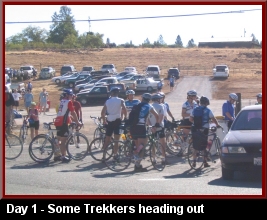 We finally made it to lunch after a rather punishing, long, slow climb up Mt. Aukum Rd. Unlike some, we resisted to temptation to flag
down a SAG (Support And Gear) vehicle to carry us up the hill. Lunch was pleasant, and we enjoyed sandwiches catered
by Ettore's. More enjoyable than the food was the chance to stretch out and relax,
replenish our Camelbacks and water bottles, and get out of the increasingly brutal sun.
We finally made it to lunch after a rather punishing, long, slow climb up Mt. Aukum Rd. Unlike some, we resisted to temptation to flag
down a SAG (Support And Gear) vehicle to carry us up the hill. Lunch was pleasant, and we enjoyed sandwiches catered
by Ettore's. More enjoyable than the food was the chance to stretch out and relax,
replenish our Camelbacks and water bottles, and get out of the increasingly brutal sun.
Speaking of water, we would later estimate that our consumption each day was somewhere between 2 and 3 gallons of water! Our
Camelbacks hold 2 liters (70 oz) and we found that we were filling them at breakfast,
lunch and every water stop (placed ever 6 - 10 miles) we could. It is also interesting to note that cycling takes incredible amounts of
energy. This meant huge breakfasts, frequent energy bars and gels, and large carbohydrate laden dinners (no Atkins
dieters on this trek).
After lunch, we continued the trek by heading uphill again and eventually winding down through the hills of
the Fairplay region . Foothill wineries
(especially in Amador County) are gaining quite a reputation for decent wine,
especially Zinfandel.
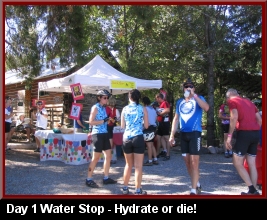 Fairplay, the next region to the North and East, and a little higher in elevation, is the latest region to start producing wine. Of course, it
is a young area as far as vines go (unfortunately, you can definitely taste the "youth" in their offerings), but in a few years (10 or 15), this
area should start to produce some killer vintages.
Fairplay, the next region to the North and East, and a little higher in elevation, is the latest region to start producing wine. Of course, it
is a young area as far as vines go (unfortunately, you can definitely taste the "youth" in their offerings), but in a few years (10 or 15), this
area should start to produce some killer vintages.
Of course, all of these vineyards provide a beautiful backdrop for cycling. We eventually reached our final "hill" and was able to start our
long slow decent to Plymouth. Downhill is a good thing, but there were a couple of other factors that were very draining: 1. The sun -
we had been biking in the sun for hours, and the vineyards aren't known for their trees. There was very little shade on this section of the
ride. The heat - did I mention that the high for the day was around 102? Despite the conditions, we finally made the last water stop
(after about 30 miles) just outside of Plymouth in Amador County. After this brief stop, we finished our day by pulling into the Placer
County Fairgrounds at about 4:30 - 7 hours after starting the trek in Apple Hill.
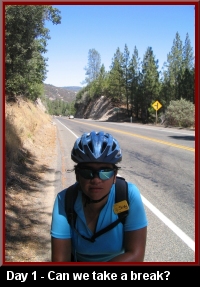 To say the least, we were exhausted. Before we could rest and seek what little shade could be found at the fairgrounds, we had
some chores to do - namely setting up our tent and sleeping bags. To be quite honest, the rest of the evening was a blur, although
I do remember quite clearly having to physically restrain Sandy from attacking her Team Captain - he was the one who convinced her
that this ride would be a piece of cake! Beer, wine and margaritas were available, but all we wanted to do was sit, drink Gatorade,
take a shower and go to sleep. Sandy was having some breathing problems (asthma probably) and I was just too exhausted to do
anything. I couldn't seem to convince my body that it was done exercising for the day - I just continued to sweat and sweat. We
attacked dinner with a vengeance and called it an early night. At this point, we were seriously wondering what we had gotten ourselves
into. We began to wonder if we would even be able to finish the trek.
To say the least, we were exhausted. Before we could rest and seek what little shade could be found at the fairgrounds, we had
some chores to do - namely setting up our tent and sleeping bags. To be quite honest, the rest of the evening was a blur, although
I do remember quite clearly having to physically restrain Sandy from attacking her Team Captain - he was the one who convinced her
that this ride would be a piece of cake! Beer, wine and margaritas were available, but all we wanted to do was sit, drink Gatorade,
take a shower and go to sleep. Sandy was having some breathing problems (asthma probably) and I was just too exhausted to do
anything. I couldn't seem to convince my body that it was done exercising for the day - I just continued to sweat and sweat. We
attacked dinner with a vengeance and called it an early night. At this point, we were seriously wondering what we had gotten ourselves
into. We began to wonder if we would even be able to finish the trek.
We were among the last people to finish on day 1. Probably the psychological low point on day 1 was when other members of
our team, who had started the trek AFTER we had and had participated in the optional 18 mile segment started passing us even before
lunch time. Hmmm....maybe there is something to those "road bikes" after all! Not that I am complaining - it's far easier to climb using
a mountain bike because of the lower gear ratio. There were points at which people were stopped or even walking their bikes where
we were able to "keep on cranking". On the downhill stretches and the flat sections, however, the only advantage we seemed to gain
by using mountain bikes was that the "road bike" dudes cruising by at incredible speeds created a nice little breeze every once in a
while.
Day 2 - Plymouth to Coloma (40.5 miles)
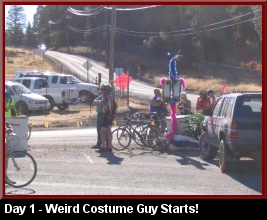 In the morning, we were feeling a little bit better. Initial drafts of the trek route indicated that there would be much less
elevation change
on day two, although a lot of it was uphill (but less of a grade).
Day 2
was also supposed to be shorter by a few miles than Day 1 with
cooler temperatures. Cautiously optimistic, we indulged in a huge breakfast, determined to get an early start. We started about 8:45.
Of course, we were some of the last people to leave, but we didn't mind - we were going to take it easy and "SAG" if we needed to.
Our principal goal was to beat the "weird costume guy". This guy pulled a little cart behind his bike (see photo) with a plant in it, lots
of feather boas (some of which were attached to his helmet), and a sign post with literature about the Sacramento Lung Association on it.
This guys was sort of like a sweeper - he was the last one in every day on purpose. If you came in behind him, you really sucked.
Not that he couldn't have been the first one across the finish line: This guy, back in 1996 participated in the American Lung
Association "Transamerica bike trek" from May 17th to July 20th. You can image our dismay at seeing this guy about to take
off at the same time that we were!
In the morning, we were feeling a little bit better. Initial drafts of the trek route indicated that there would be much less
elevation change
on day two, although a lot of it was uphill (but less of a grade).
Day 2
was also supposed to be shorter by a few miles than Day 1 with
cooler temperatures. Cautiously optimistic, we indulged in a huge breakfast, determined to get an early start. We started about 8:45.
Of course, we were some of the last people to leave, but we didn't mind - we were going to take it easy and "SAG" if we needed to.
Our principal goal was to beat the "weird costume guy". This guy pulled a little cart behind his bike (see photo) with a plant in it, lots
of feather boas (some of which were attached to his helmet), and a sign post with literature about the Sacramento Lung Association on it.
This guys was sort of like a sweeper - he was the last one in every day on purpose. If you came in behind him, you really sucked.
Not that he couldn't have been the first one across the finish line: This guy, back in 1996 participated in the American Lung
Association "Transamerica bike trek" from May 17th to July 20th. You can image our dismay at seeing this guy about to take
off at the same time that we were!
Quickly we grabbed our daily route map from the starter and pedaled out of the Fairgrounds. We stopped just outside to check the route
and quickly became alarmed: Day 2 (which was supposed to be shorter) had morphed into an almost entirely uphill 40.5 mile day!
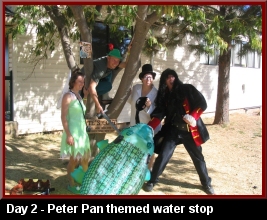 I was ready to throw my helmet down in disgust and call a cab to take me back to our car. It had been my job on Day 1 to encourage Sandy
and to convince her that we could make it through to the end of the day. On Day 2, it was her responsibility to encourage me. After
applying generous amounts of sunscreen (SPF 30+, I might add). Again, the organizers of this event did their best to encourage their
riders - the first 8 miles or so were nearly all downhill - dropping about 800 feet in elevation. The first 8 miles were a breeze, giving us
much needed confidence.
I was ready to throw my helmet down in disgust and call a cab to take me back to our car. It had been my job on Day 1 to encourage Sandy
and to convince her that we could make it through to the end of the day. On Day 2, it was her responsibility to encourage me. After
applying generous amounts of sunscreen (SPF 30+, I might add). Again, the organizers of this event did their best to encourage their
riders - the first 8 miles or so were nearly all downhill - dropping about 800 feet in elevation. The first 8 miles were a breeze, giving us
much needed confidence.
We had our first water stop of the day in the lovely town (if you can call 2 buildings a town) of Latrobe, not far from where I work at
DST Innovis
(about 4 miles further down the road). The theme of this water stop was "Peter Pan", and we were entertained by
the same guy who dressed up as Marilyn Monroe on Day 1, this time dressed as Captain Hook. From this water stop, we headed gradually
uphill through some of the best scenery on the ride - rolling, gentle, golden-brown hills on small country roads out in the middle of nowhere.
There were some great downhills too! With the bike computer, I was able to get our speed at any given time. While it's depressing to see
yourself going 7 miles an hour uphill, it's refreshing to see 27-30 mph downhill speeds too! The downhills really eat up the miles!
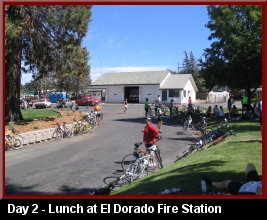
We had lunch at the El Dorado Fire Station after about 20 miles. It was amazing. We actually felt fine! No soreness, not really tired.
We began to think that we might actually finish this thing! The rest of the day as absolutely gorgeous! At one point we had received
permission to trek through a private community on Stagecoach Road - home to multi-million dollar ranches, private lakes, a community
stable with miles and miles of horse trails!
There was one last hurdle for the day: Lotus Grade. Lotus grade (in the direction that we were traveling) is a winding, rather steep uphill for
about 3 miles, with a huge payoff at the end: A 5 mile downhill at 10% grade that would dump us out at our campsite for the evening: The
Coloma Resort . There was a water stop at the bottom, just before the climb. The main topic of
conversation? Should we ride it, or SAG it? We were determined to do it. The climb really wasn't that bad and the downhill at the
end was awesome! My bike computer calculated what was to be my top speed of the trek: 41 MPH. Do you have any idea what it
feels like to be going 41 miles per hour on a bicycle? Exhilarating is one word for it. Scary is another.
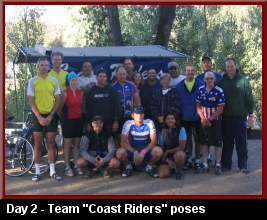 Coloma is a really cool foothill town: It's the starting point of intermediate level whitewater
adventures on the American River and also the site where gold was discovered back in 1849 starting the California Gold Rush. The
Coloma Resort was a great place to spend the rest of the afternoon. We got in around 3:00 (quite a change from the day before)
and leisurely setup our tent then went over to try out the pool. Sandy made it all the way in, but I only managed to get my legs
wet: This Florida boy can't handle water with temperatures in the upper 50s/lower 60s. We finally were able to sample the
margarita tent and have some snacks. After dinner, the was music (DJ) and dancing. On day two, we did a "poker run",
collecting a new playing card at each water stop, lunch and the finish line. I actually won a prize (there were prizes for the
15 highest hands) for my 3 Jacks! Our team, Coast Riders from Sandy's work
actually had 3 members win prizes in the poker run!
Coloma is a really cool foothill town: It's the starting point of intermediate level whitewater
adventures on the American River and also the site where gold was discovered back in 1849 starting the California Gold Rush. The
Coloma Resort was a great place to spend the rest of the afternoon. We got in around 3:00 (quite a change from the day before)
and leisurely setup our tent then went over to try out the pool. Sandy made it all the way in, but I only managed to get my legs
wet: This Florida boy can't handle water with temperatures in the upper 50s/lower 60s. We finally were able to sample the
margarita tent and have some snacks. After dinner, the was music (DJ) and dancing. On day two, we did a "poker run",
collecting a new playing card at each water stop, lunch and the finish line. I actually won a prize (there were prizes for the
15 highest hands) for my 3 Jacks! Our team, Coast Riders from Sandy's work
actually had 3 members win prizes in the poker run!
All in all, Day 2 was the best day of the trek, despite being the longest in miles. We actually had energy to sit around and talk with
some of the other 300+ riders in the trek, explore the river and enjoy some adult beverages. The pressure was off too - Day 3 was
only 22 miles (or 19 if we used the alternate starting point - which we did). We were in bed by about 10:00 pm.
Day 3 - Coloma to Apple Hill (22 miles)
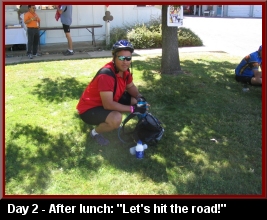 For the masochistic, Day 2 began with a climb back up Lotus Grade (10% grade for 3 miles uphill), or for the sadistic (that's us), a
shuttle van to the "alternate start" at the top. While after this trip, we look at the "bumps" (you really can't call them hills) on the bike
trail in Sacramento as a joke, we weren't exactly stupid either. Good thing too.
Day 3
took us almost exclusively
uphill. We spent a
lot more time in that really nice neighborhood on Stagecoach Rd a lot more - most of that section was uphill. We made good time and
got into Placerville in just a few hours. Of course, that was the easy part. We still had what was (in my opinion) the toughest section
of the entire trek to complete: 6 miles, all uphill, with an elevation gain of about 1,400 feet to go.
For the masochistic, Day 2 began with a climb back up Lotus Grade (10% grade for 3 miles uphill), or for the sadistic (that's us), a
shuttle van to the "alternate start" at the top. While after this trip, we look at the "bumps" (you really can't call them hills) on the bike
trail in Sacramento as a joke, we weren't exactly stupid either. Good thing too.
Day 3
took us almost exclusively
uphill. We spent a
lot more time in that really nice neighborhood on Stagecoach Rd a lot more - most of that section was uphill. We made good time and
got into Placerville in just a few hours. Of course, that was the easy part. We still had what was (in my opinion) the toughest section
of the entire trek to complete: 6 miles, all uphill, with an elevation gain of about 1,400 feet to go.
This was pretty brutal. Luckily, we had the one of the SAG guys shadowing us. He would pull ahead of us and break out his
"water sprayer" and drench us as we road by. Talk about refreshing! Finally, we pulled into the same place that we started from:
Abelís Acres in Apple Hill. After checking in and loading our bikes on the car, we headed over to the BBQ. Surprisingly, most people
had already enjoyed the final BBQ and were heading home. We were pretty exhausted and did the same. It was quite a relief that
we did not need to setup a tent for a 3rd night (and the exhausting ritual of inflating air mattresses by hand - er...mouth) - we would
sleep in the comfort of our own bed. Of course, there was the mandatory soak in our
hot tub as well!
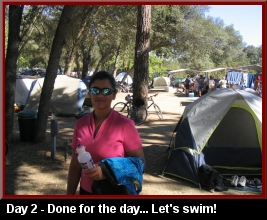
The Aftermath
A few days later, I was on the way home from work when I spotted a few bikers crossing the bridge at the
Nimbus Fish Hatchery in Sacramento.
Wistfully, I thought, "Wow, they're so lucky to be outside on a bike." Quite a change from when we started this whole thing. Now,
I can't let more than a few days go by without putting a few miles on my bike. And our definition of "a few miles" has changed also -
we don't call anything under 20 miles a bike ride anymore! Unfortunately, the days are getting shorter and it's becoming difficult to
get in 18 miles (our standard "around the lake" route) in before dark after work. Oh well. We still ride on the weekends, and we'll
probably do quite a few "spinning" classes at the gym this winter. It's also interesting to note this fact: 35 miles in the foothills
took us 7 hours to complete. We can do the same distance in the valley on flat ground in about 2 and a half hours.
Next year, they are moving the trek from the foothills (elevations between 800 and 2,600 feet) to Truckee near lake Tahoe (elevations
around 6,500 feet). 100 miles of cycling at altitude? Are we crazy enough to try it? Sure....why not? We'll train, better, harder and faster
next year! The really sick part of this whole experience is that it was actually addictive. We're now looking at other trek options during
the year, and I think I am crazy enough to want to attempt a century(100 miles) or metric century (100 kilometers - near 70 miles) next year.
There seems to be a fugue that sets in after a few miles on a bike.
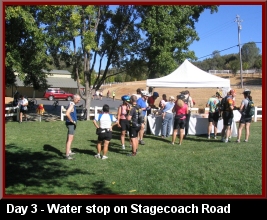 The pain is finished and you feel like you can go forever. Of course,
the 5 miles leading up to this stage is anything but pleasant!
The pain is finished and you feel like you can go forever. Of course,
the 5 miles leading up to this stage is anything but pleasant!
Clean Air
In the end (according to the Sacramento Lung Association Web page), the organization raised somewhere around $269,000
by putting on this event. We couldn't help but laugh (as our lungs were burning on several of the climbing sections of the trek) at
the irony of this event being sponsored by the Sacramento Lung Association. As I am writing this web page, California has just
passed a law requiring auto makers to manufacture vehicles that produce less pollution. The new regulations, which will be
phased in beginning in 2009, are expected to cut exhaust emissions in cars and light trucks by 25 percent, and in larger
trucks and SUVs by 18 percent. Because California enacted emission control laws before the Federal Government, we have the
right to make our own laws. Other states use California as a guide: They can either accept Federal or California State guidelines
for their own.
 California makes up about 10% of the US market in automobile sales, so manufactures usually manufacture cars to
California standards, regardless of where they are being sold in the US.
California makes up about 10% of the US market in automobile sales, so manufactures usually manufacture cars to
California standards, regardless of where they are being sold in the US.
As a residents of Sacramento County, clean air is important to us. Every summer we are subjected to numerous "Spare the Air"
days where the local government and press make a genuine effort to communicate the need to drive less. Out here, our primary
pollutant is ozone. On days over 100 degrees, the Sacramento Valley can become a smoggy mess. For many people, this results
in difficulty breathing and really brings out the worst in folks who suffer from asthma. We're not quite as bad as Los Angeles, but
anytime the weather and pollution causes problems in breathing, it's time to take things seriously. Of course, we're now big
fans of "alternative transportation" - specifically, biking ::wink, wink::
As a final thought, we would like to thank all of you that supported us financially (raised around $400 each for the Sacramento
Lung Association) and emotionally. We couldn't have done this without you. We'll see you next year!
 It started so innocently: Sandy (my wife) sent me a rather innocuous e-mail one day at work in the early
spring of 2004: "Would you be interested in doing a
3 day bike trek
in September to benefit the Sacramento Lung Association?" My idea of exercise
at the time was limited to heavy "channel surfing" on Dish Network in the
evenings after work, coupled with the occasional trip to the refrigerator for a soothing beverage and maybe
some popcorn. The ski season was winding down and Sandy was gently
and patiently doing her best to get me off the couch and out into nature. So partly due to couch-potato
induced guilt and partly at the suggestion of my wife, I said, "Sure. Why not?" I mean, really...how hard
could it be?
It started so innocently: Sandy (my wife) sent me a rather innocuous e-mail one day at work in the early
spring of 2004: "Would you be interested in doing a
3 day bike trek
in September to benefit the Sacramento Lung Association?" My idea of exercise
at the time was limited to heavy "channel surfing" on Dish Network in the
evenings after work, coupled with the occasional trip to the refrigerator for a soothing beverage and maybe
some popcorn. The ski season was winding down and Sandy was gently
and patiently doing her best to get me off the couch and out into nature. So partly due to couch-potato
induced guilt and partly at the suggestion of my wife, I said, "Sure. Why not?" I mean, really...how hard
could it be?













